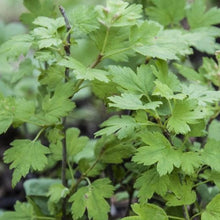Characteristics
The alpine currant is also called mountain currant. It bears the botanical species name Ribes alpinum. It can reach heights of growth of 1.5-2 meters and widths of 0.8-1.5 meters. The growth can be described as upright and bushy.
Pollination and foliage
Ribes alpinum is diocesan. The flowers are grape-shaped and are characterized by a greenish-yellow color. You can enjoy the blossoms in April as well as in May. The green leaves are 3-5 lobed. They have an egg-shaped to rounded shape.
Soil condition
Ribes alpinum has a weakness for calcareous and moderately nutrient-rich soils. Especially when it comes to the already mentioned nutrient content, the mountain currant takes it a bit more precisely to the chagrin of the owner. Planting on soils with a low nutrient content punishes Ribes alpinum with a small or small growth. A Ribes alpinum in no way thanks a luxury supply. In such a case, the mountain currant simply falls apart. If planted successfully, however, it compensates us for its well-developed root system with its hardly any need for care.
Provenance
Ribes alpinum is common in central and northern Europe. They can also be found in the mountains of southern Europe and Asia. In the Alps, the hardy plant penetrates to heights of up to 1820 meters.
Uses
Ribes alpinum can score with several possible uses. In addition to planting as a hedge, Ribes alpinum is ideal for the ecological upgrading of deciduous forests and herbaceous mixed mountain forests. In addition to the local use as an important nutrient for birds, the good ability to compensate for exhaust gases can also be emphasized.


